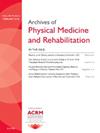开发并验证用于预测颈脊髓损伤后机械通气的新型提名图。
IF 3.6
2区 医学
Q1 REHABILITATION
Archives of physical medicine and rehabilitation
Pub Date : 2025-06-01
DOI:10.1016/j.apmr.2024.09.016
引用次数: 0
摘要
目的本研究旨在调查孤立性颈椎脊髓损伤(cSCI)患者需要机械通气(MV)的相关风险因素,并构建一个提名图预测模型:设计:回顾性分析研究:2006年至2021年间,国家脊髓损伤模型系统数据库(NSCID)共收治了5784例cSCI患者(N=5784):NSCID的观察数据最初是在康复住院期间收集的:干预措施:不适用:采用单变量和多变量逻辑回归分析来确定影响cSCI患者使用中压的独立因素,并利用这些独立影响因素建立了一个提名图预测模型。采用受试者工作特征曲线下面积(AUROC)、校准曲线和决策曲线分析(DCA)分别评价模型的效率和临床应用价值:在一系列纳入的 5784 例患者中,有 926 例(16.0%)因需要 MV 而进入脊髓模型系统住院康复。逻辑回归分析表明,相关损伤、美国脊髓损伤协会(ASIA)损伤量表(AIS)、上肢各肌段单侧最佳运动评分总和(sUEM)和神经损伤程度(NLI)是使用 MV 的独立预测因素(pConclusion):基于sUEM、NLI、相关损伤和AIS的提名图预测模型可以准确有效地预测cSCI患者使用中风的风险,帮助临床医生筛查高危患者并制定有针对性的干预措施。本文章由计算机程序翻译,如有差异,请以英文原文为准。
Development and Validation of a Novel Nomogram for Predicting Mechanical Ventilation After Cervical Spinal Cord Injury
Objective
To investigate the risk factors relating to the need for mechanical ventilation (MV) in isolated patients with cervical spinal cord injury (cSCI) and to construct a nomogram prediction model.
Design
Retrospective analysis study.
Setting
National Spinal Cord Injury Model System Database (NSCID) observation data were initially collected during rehabilitation hospitalization.
Participants
A total of 5784 patients (N=5784) who had a cSCI were admitted to the NSCID between 2006 and 2021.
Interventions
Not applicable.
Main Outcome Measure(s)
A univariate and multivariate logistic regression analysis was used to identify the independent factors affecting the use of MV in patients with cSCI, and these independent influencing factors were used to develop a nomogram prediction model. The area under the receiver operating characteristic curve (AUROC), calibration curve, and decision curve analysis (DCA) were used to evaluate the efficiency and the clinical application value of the model, respectively.
Results
In a series of 5784 included patients, 926 cases (16.0%) were admitted to spinal cord model system inpatient rehabilitation with the need for MV. Logistic regression analysis demonstrated that associated injury, American Spinal Cord Injury Association Impairment Scale (AIS), the sum of unilateral optimal motor scores for each muscle segment of upper extremities (sUEM), and neurologic level of injury (NLI) were independent predictors for the use of MV (P<.05). The prediction nomogram of MV usage in patients with cSCI was established based on the above independent predictors. The AUROC of the training set, internal verification set, and external verification set were 0.871 (0.857-0.886), 0.867 (0.843-0.891), and 0.850 (0.824-0.875), respectively. The calibration curve and DCA results showed that the model had good calibration and clinical practicability.
Conclusions
The nomograph prediction model based on sUEM, NLI, associated injury, and AIS can accurately and effectively predict the risk of MV in patients with cSCI, to help clinicians screen high-risk patients and formulate targeted intervention measures.
求助全文
通过发布文献求助,成功后即可免费获取论文全文。
去求助
来源期刊
CiteScore
6.20
自引率
4.70%
发文量
495
审稿时长
38 days
期刊介绍:
The Archives of Physical Medicine and Rehabilitation publishes original, peer-reviewed research and clinical reports on important trends and developments in physical medicine and rehabilitation and related fields. This international journal brings researchers and clinicians authoritative information on the therapeutic utilization of physical, behavioral and pharmaceutical agents in providing comprehensive care for individuals with chronic illness and disabilities.
Archives began publication in 1920, publishes monthly, and is the official journal of the American Congress of Rehabilitation Medicine. Its papers are cited more often than any other rehabilitation journal.

 求助内容:
求助内容: 应助结果提醒方式:
应助结果提醒方式:


